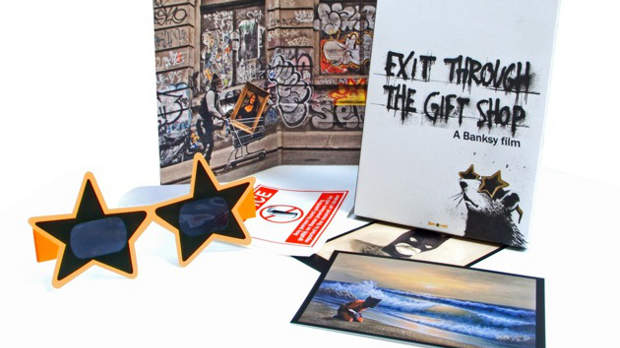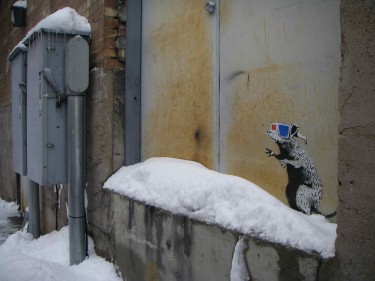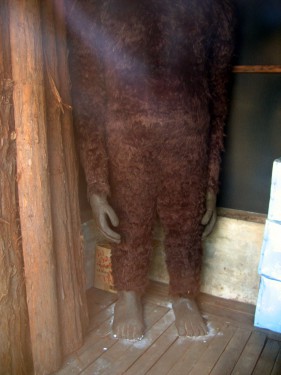 Back to selection
Back to selection
Exit Through The Gift Shop

A year after legendary street artist Banksy’s film Exit Through the Gift Shop premiered at Sundance 2010, it still feels vital and fun upon its DVD release, a great roller coaster ride that is not only an entertaining mystery but a pinpoint observation on today’s art world. The film explores the underground street art scene and its anonymity, then segways into the notions of art vs. vandalism, appreciation vs. random collection, and spontaneity vs. calculated hype. When its screening was announced right before the festival, people either thought, “holy shit, Banksy made a film?!?!” or “what’s street art?” As the festival started, at least four Bansky stencils showed up on walls around town – he was there.
The excitement kept up through the film’s screenings – while most audiences were big fans or became instant fans, the film also gave folks a lot of questions and endless discussions started up. Was that really Banksy in the film? Was Mr Brainwash all made up? Why is it bashing the art world but selling art? Questions to the point of “I heard he had a ton of lookouts when he tagged the West Bank wall.” (OK – what did YOU do when you tagged it?)
The documentary is made by a talented street artist that goes by the name Banksy. No one knows who he is, successfully staying anonymous for years now. People care about who he is because his art has the great combination of being both beautiful and something that makes a statement. The fact he is still unknown after being successful at putting art up around the world and also selling it on occasion at the luxurious Sotheby’s, just pumps up the mystique.
Street art as a subject is deceptive. It’s packed with power, but many dismiss it. It’s layered with the connotation: well that’s nice and pretty, but I could have done that. But you have to remember, you didn’t do it. And that’s a big thing. An even bigger thing is – why don’t you do it? Take a stand, mark a wall, be a pirate – but have something to say. It’s a powerful feeling to walk up to someone’s artwork when you’ve heard all about them but they don’t exist until you are physically in front of them, whether its a museum or alley.
Exit covers the best street artists because it’s a documentary about this guy Thierry, who is an incredibly obsessed guy with a video camera. He got obsessed on his cousin, the artist Space Invader, then on Shepard Fairey (creator of Andre the Giant Has A Posse), before being lucky enough to become Banksy’s Dad-with-a-camera, following him around the world. Thierry’s hours and hours (probably adding up to literal years) of footage makes Exit not only fun but important. When Thierry fails to make his own art documentary out of the footage, Banksy steps in with a team and make the film instead, focusing on the art scene but also on Thierry, who careens out of control and becomes an artist on steroids nicknamed Mr. Brainwash.
The film was a big hit and made a lot of money in theaters, at least for a street art documentary made by a secret person. Banksy’s work, as is the case with most street art, makes the police and government very mad. If not for the simple case of vandalism, then for the very specific social and political criticism the art has. Many times its just art on a wall, at its best it makes a strong statement, at my favorite its also existential, making you notice things you might miss in life. With the best artists it’s all of these things, making the world a better place. And it’s free to look at.
Then it gets confusing – once his art started selling for huge amounts of money, the establishment started caring. If he tags a wall, it’s either stolen – the wall is stolen – or the owner carefully covers it with Plexiglas or something to preserve it. And if the art was intended to make a statement, how is the statement changed when it becomes an object for sale? Hype and money affect criticism. In both ways, if there is too much of them, or not enough.
I think the film really says all the things we want to hear about art – its great and should be free – and people with money might be fucking it all up. But then, who takes the money that’s spent? It’s complex. Mr Brainwash is such a perfect villain that it’s hard to believe its not all a master plan by Banksy to comment on the art world, with Thierry being Tony Clifton to Banksy’s Andy Kaufman. That said, Thierry does seem crazy and out of control. For years around Los Angeles and long before this film, other filmmakers would talk about Thierry, this “crazy Frenchman” who was everywhere, filming everything – they wanted to get the footage so bad.
All of this “did it happen, does it matter” makes me happy, though, and I’ll watch this film over and over and keep talking about it with friends, arguing over intent, laughing over results, enjoying the art.
While the extras are far less than a second disc, their content is worth watching. “B Movie” is a nice, more straight forward doc about Banksy and his art. “More brainwashing” is more charming footage of Thierry that was cut out of the film and is interesting but not vital. The supposed doc that Thierry was making, “Life Remote Control,” that no one seems to think was ever made, is on the extras but only 14 minutes worth. It feels like more outtakes, but its cool, with interview footage of Ron English, Shepard, Malcolm McLaren and other citizens of the night. The packaging of the disc is top notch and great to hold, as usual with the Oscilloscope masterminds, and the disc comes with stickers and ultraviolet “star” glasses.
photos by Mike Plante:
-Frank Morris’ paper mache head at Alcatraz, which he used to fool guards and escape forever. The cell is real, but the actual head is a recreation. The real one disintegrated decades ago.
-two of Banksy’s pieces in Park City from last year. The 3-D rat was on the back of the Egyptian (I heard the door was removed and saved) and the snow angel was down an alley off Main St. Another one was a chimp on a city power box, and a fourth was a cameraman filming a pretty flower while simultaneously pulling it from the ground was on the side of a coffeehouse, quickly covered with plexiglas. Then again, how do I know Banksy did them?
-bigfoot statue at a official museum outside Santa Cruz, CA.
[AMAZONPRODUCT=B00470MG06]
[AMAZONPRODUCT=B004FK40J8]




